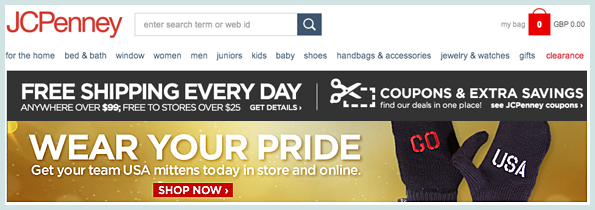So, The Seattle Seahawks thrashed the Denver Broncos at the NFL Super Bowl in New Jersey last night. Big deal. Seen one touchdown? Seen them all. Rather, we were on the edge of our seats, waiting to see which brand would win the coveted ‘most talked about tweet’ accolade.
With an average 108.7 million viewers per game – a large proportion of whom engage in real-time social media activity throughout – the Super Bowl is a pivotal opportunity in the marketing calendar.
Last year, Oreo famously took the content crown with its now infamous tweet published during the mid-game stadium blackout, reminding Super Bowl fans that they could ‘still dunk in the dark’. Oreo wasn’t a sponsor of the event, yet its spontaneous newsjacking approach earned it supreme kudos in the buzz stakes.
According to TweetReach, this year’s winner in terms of social media buzz was US retailer JCPenney. So what was JCP’s content strategy, and how did it perform so well?
The JCPenney stunt
During the first half of the big game, two rather incoherent tweets were posted to JC Penney’s @jcpenney Twitter account.
Tweet one read: Toughdown Seadawks!! Is sSeattle going toa runaway wit h this???
Tweet two followed with: Who kkmew theis was ghiong tob e a baweball ghamle. #lowsscorinh 5_0
Cue a flurry of tweets suggesting the brand’s Twitter account had been left in the hands of an inebriated social media manager. As well as digs from the general public, JCPenney’s garbled tweets aroused a few humorous replies from huge US brands, including Macy’s, Snickers and Kia Motors America (more on this later).
Having captured the attention of social media users worldwide, the twittering public and a raft of news sites began theorising over whether JCPenney was indeed sending out drunken tweets or had been hacked.
Of course, neither was the case and JCPenney soon revealed that its muffled updates were the result of ‘tweeting with mittens’ – a strategically-planned viral effort.
Was it a success?
You know the old adage all press is good press? It seems apt in this case, as by tweet number three, JCPenney had generated a lot of conversation. Some of it was positive, much of it was negative, but all of it was getting the brand discussed – in some cases even amplified by other major brands with significant reach.
According to TweetReach analysis shared by MarketingLand, the first two tweets generated 41,000 retweets (the first at 19,000 retweets; the second at 22,000 retweets).To add some context, Oreo’s big blackout hit last year maxed at 16,000 retweets.
As mentioned, brand amplification played a crucial role in this viral campaign. To exemplify, Coors Light teased that JCP should “tweet responsibly” (while plugging its own beverage as an ideal football accompaniment, naturally) – this generated 7,000 retweets at last count. Meanwhile Doritos’ suggestion that JCP might need some, well, Doritos to line the stomach, racked up 1,400 retweets.
JCP’s concluding ‘mitten confession’ tweet only racked up 3,600 tweets at last count, suggesting that people aren’t so engaged when the content reveals itself to be a marketing ploy. It seems the idea of a drunken social media intern facing the boot or a big-brand hacking story is far more gripping.
That said, overall sentiment has been positive for JCPenney, according to Jenn Deering Davis, co-founder of Union Metrics, the company behind TweetReach.
“Most people were just making jokes and commenting on the weird tweets,” he explained.
“Only 550 tweets about JCP used the word “fail” (out of 131k total tweets for the day). Overall, it seems like this strategy worked for them – they typically average around 1,800 tweets a day, and they got more than 130,000 today.”
Over to you
What do you make of JCPenney’s Super Bowl Twitter tactics? Quirky and clever or just too try-hard?

